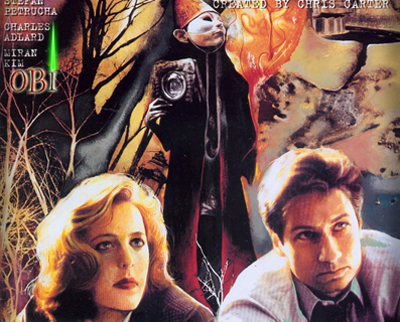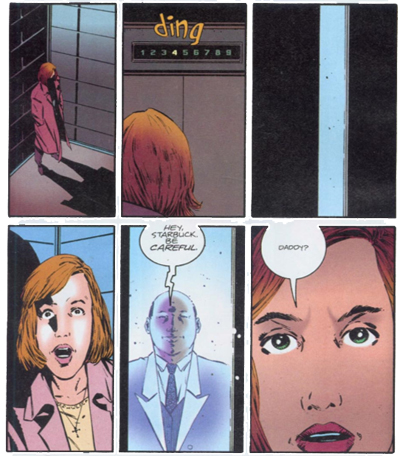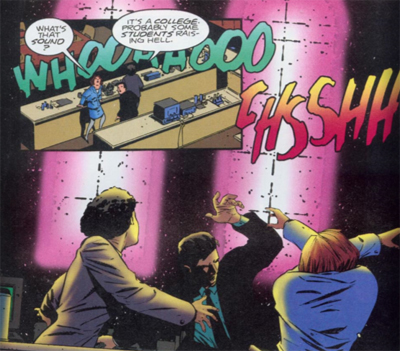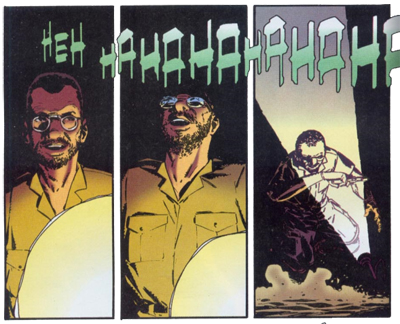This August (and a little of September), we’re taking a trip back in time to review the second season of The X-Files. In November, we’ll be looking at the third season. And maybe more.
No matter how you cut it, the creative team of Stefan Petruscha and Charles Adlard were prolific. The duo only worked on The X-Files comics book for seventeen months between January 1995 and May 1996, but they put out a phenomenal amount of work. On top of sixteen issues of the monthly series, there were also two digests, a number of short stories and an annual. In most cases, some of this work would be outsourced to another creative team, but Petrucha and Adlard remain the creative team for Topps’ X-Files comic.
While this undoubtedly required a great deal of creative energy from Petrucha, churning out scripts on a regular basis, it is worth pausing to praise artist Charles Adlard. These days, for a variety of reasons, it seems that major comic book artists have difficulty producing twelve twenty-odd-page issues in a year. Not only was Adlard able to meet that objective, he was able to do that while drawing a large volume of supplementary material, including this feature-length annual.
It’s remarkable how consistent it all is. One of the advantages of a tie-in comic book with a steady creative theme is that there’s a much clearer authorial voice. Although Chris Carter oversaw the production of The X-Files, the demand of weekly network television mean that some episodes got more attention than others, and that particular voices tend to shine through. Darin Morgan writes his own version of The X-Files, as do Glen Morgan and James Wong or Howard Gordon or Vince Gilligan. (This isn’t a bad thing, by the way.)
On a comic, with all the issues written by the same author and illustrated by the same artist, there is a bit more consistency. Even though Hallow Eve is a stand-alone one-shot story that exists quite separate to Petrucha and Adlard’s twelve-issue meta-arc, it fits quite comfortably with their themes and subtexts. It’s an episode about history and memory, and perception and reality.
It is also interesting that Hallow Eve is a story based around Scully. Scully is very much a supporting character for Petrucha and Adlard’s run. This may be due to the fact that the comic launched following Anderson’s limited availability at the start of the second season, but it may also be because Scully is a tougher character to write. Whatever the reason, Petrucha and Adlard’s run is largely driven by Mulder.
This doesn’t mean that Petrucha and Adlard have ignored Scully. Her religious faith plays a small role in Not To Be Opened Until X-Mas and she gets a lovely narration at the start of the second issue of Firebird. At the same time, there’s a sense that pair are having trouble with her character. Not To Be Opened Until X-Mas requires a pretty major screw-up from Scully to get the plot moving, while Firebird has Scully actually seeing a very alien alien – completely affirming Mulder’s world view and shedding a lot of plausible deniability.
A lot of this comes down to the fact that a comic book is always going to operate at a level of hokeyness and that The X-Files comic is – by its nature – going to be a bit heightened when compared to the series. On the show, Mulder gets to be right most of the time. In the comic, Mulder gets to be even more right. The aliens that show up in Firebird cannot be written off as the result of grotesque and amoral government experiments, looking more like something from the work of H.P. Lovecraft than a child in a little grey alien costume. That’s harder to rationally write off.
So it’s nice that Petrucha and Adlard decide to devote the comic’s first annual to a Scully story. In fact, while Hallow Eve contains quite a few inexplicable supernatural occurrences, it works very hard to present a mystery that Scully can solve somewhat rationally. Again, this an X-Files comic book, so the standards of “rationally” are a little lax. The comic suggests the explanation for the haunting is mostly grounded, but it still relies on meticulously calibrated projections and post-hypnotic suggestion.
Still, Petrucha does good work with Scully here, trying to explain how Scully can be witness to all this strange stuff and still remain skeptical. “Come on — after all we’ve been through?” Mulder asks, giving voice to a particular strain of fan criticism of Scully’s character. “You’ve seen creatures from space… held an alien fetus in your hands! How can you still cling to that world view according to Hoyle?” It’s a perfectly reasonable observation.
In fairness to Petrucha, he handles the issue the same way that he does in Firebird. He suggests that Scully’s decision to ground her approach in the scientific method is not the same as outright denial of the supernatural. “Mulder,” she states, “first of all, science is not a vision of the world, it’s a method of processing.” Scully doesn’t so much refuse to believe as she has a different way of processing the information, maintaining a higher level of scrutiny. (The show does suggest that this approach grants Mulder more legitimacy than he might otherwise have.)
More than that, though, Hallow Eve works hard to reconcile the supernatural with a more rational understanding of the universe. The two need not be at odds with one another – just as science and religion are not mutually exclusive. Walpola, a psychic brought in to consult, muses on a possible rational explanation for ghosts. “I mean, on a purely practical level, we all carry around our parents’ voices in our heads — right?” she asks. When Scully begins to reject, she continues, “But nothing. If we all came from this hunk of stone… how can it not be haunted?”
It is possible to think of ghosts as things that exist metaphorically and abstractly rather than on a literal plane. As fun as it is to think about ectoplasm and possession, ghosts serve quite effectively as a way of metaphorically linking the past to the present, of acknowledging an impact that extends from times long past – of suggesting consequences and legacies that live on long after the person in question. Petrucha suggests that perhaps Mulder and Scully’s perspectives are not entirely at odds with one another.
Perspective is one of the core themes of Petrucha and Adlard’s run, suggesting how memory and experience shape people. This is at work throughout Hallow Eve, from the way that Jonah Brockford is motivated by his memory of Lilith and to how Scully’s memory of her father influences her. The ghosts that haunt the bone at the centre of the story are really just the legacy of past events. “I’ve been locked in the past too long,” Brockford confesses early in the story, and it is suggested that perhaps the pas is ultimately inescapable.
In keeping with these themes of perspective and perception, the story even closes with a short scene at “The Foucault Institute for the Criminally Insane.” It’s a nice in-joke, considering Foucault’s theories about how society exercises power by defining things like mental illness. Perception and reality can become so entangled they are impossible to separate in practical terms. “It is not, however, unusual for accident victims to die, not from the impact, but from fear,” Scully reflects during an autopsy. “The awareness of impending death is, itself, often enough to kill.”
Hallow Eve continues Petrucha and Adlard’s hot streak of inventing their own X-files, taking a bit of weird science and expanding it into a story in such a way that one could imagine that show starting from a similar premise. In this case, Hallow Eve builds from the concept of “the mitochondrial Eve”, a fascinating scientific concept first proposed in 1987 by Rebecca Cann, Mark Stoneking, and Allan Wilson. Even name is a union of scientific theory and religious iconography, making it the perfect subject for a Scully-centric story, without labouring the point.
The macguffin even fits comfortably with the theme of the story – the idea that all humans inherit their mitochondrial DNA from the same source, a little piece of that one individual that has remain intact for hundreds of millennia. If that much can pass from person-to-person for so long, it makes a great deal of sense that characters would be haunted by their parents or by previous love affairs.
Hallow Eve is a delightful little story, and a testament to the efficiency and prolificity of Petrucha and Adlard as a creative team, as well as a reminder of just how well Topps’ X-Files comic was working.
You might be interested in our other reviews of the second season of The X-Files:
- Little Green Men
- The Host
- Blood
- Sleepless
- Duane Barry
- Ascension
- 3
- One Breath
- Firewalker
- Red Museum
- Excelsis Dei
- Aubrey
- Irresistible
- Die Hand Die Verletzt
- Fresh Bones
- Colony
- End Game
- Fearful Symmetry
- Død Kälm
- Humbug
- X-tra: (Topps) Trick of the Light
- The Calusari
- F. Emasculata
- Soft Light
- X-tra: (Topps) #4-6 – Firebird
- Our Town
- Anasazi
- X-tra: (Topps) #7 – Trepanning Opera
- X-tra: (Topps) Annual #1 – Hallow Eve (Review)
Filed under: Comics, The X-Files | Tagged: Charles Adlard, eve, faith, ghosts, history, memory, mitochondrial eve, mulder, rational, religion, scully, Stefan Petrucha, the x-files, Topps, x-files |




























Another nice review! I appreciate the compliments and the attention. Two bits of info you may find interesting.
In my original FIREBIRD script, Scully does NOT see the alien. The description specifies she only sees a blur of light reflected in a mirror. Charlie was doing a lot of work very quickly, drew it as you see in the comic, and there wasn’t time to change it prior to publication.
The original villain in ALL HALLOWS EVE was actually one of the Eve’s from the first season XF episode, Eve. She wanted to track down the first human’s DNA in the hopes it might cure her own psychosis.
Unfortunately, 1013 nixed that – not wanting me to use any of the “monsters” from the show.
Thanks again!
Thanks for the comment. I didn’t know that about the Eve – it would make sense with the title, as well. I know you like your wordplay, so Hallow Eve would make it a wordplay hat-trick. (As in the day, as in mitochondrial Eve, as in the character Eve.)
I also didn’t know that about Firebird. It’s understandable and – to be fair – the show has Scully encounter a shape-shifting alien bounty hunter at the climax of Colony and start of End Game. Nisei and 731 work hard to give her a plausible explanation for everything, but we’re nearing the point of no return for Scully’s skepticism any way – the critical mass, where it becomes a little harder to accept.